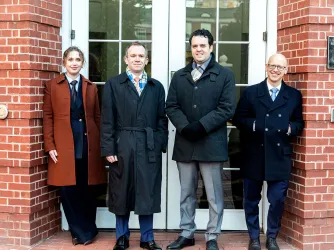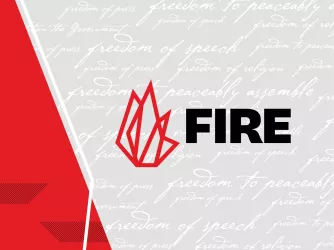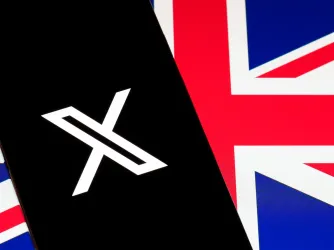Table of Contents
Banned Books Week exclusive: The "Howl" obscenity trial opinion

“I saw the best minds of my generation destroyed by madness, starving hysterical naked...”
Allen Ginsberg’s poem “Howl” chronicles the plight of the 1950s Beat Generation and shocked the nation. But beyond its cultural impact, “Howl” led to a landmark 1957 court decision which helped to further solidify the most speech-protective obscenity test to date, set forth by the Supreme Court’s decision in Roth v. United States earlier that year.
In honor of Banned Books Week, FIRE’s First Amendment Library is making available a copy of the fully cited trial court opinion for the People of the State of California v. Lawrence Ferlinghetti, which was never officially published by the Municipal Court of the City and County of San Francisco. While copies of this opinion have floated around, this one, prepared by David Skover and the First Amendment Library’s editor-in-chief, Ronald K.L. Collins, is the only copy complete with citations.
With this opinion, Judge Clayton Horn ruled that “Howl and Other Poems” was not obscene, clearing City Lights Bookstore co-founder Lawrence Ferlinghetti of charges for willfully and lewdly printing, publishing, and selling obscenity. Prior to this decision, over 500 copies of “Howl and Other Poems” had been seized by the San Francisco Collector of Customs.
Key to Horn’s decision is his analysis of “Howl” and the “redeeming social importance” of the poem, an important prong of the obscenity test laid out in the Supreme Court’s Roth decision:
I do not believe that “Howl” is without redeeming social importance. The first part of “Howl” presents a picture of a nightmare world; the second part is an indictment of those elements in modern society destructive of the best qualities of human nature; such elements are predominantly identified as materialism, conformity, and mechanization leading toward war. The third part presents a picture of an individual who is a specific representation of what the author conceives as a general condition.
Horn goes on to acknowledge the subjective nature of obscenity laws:
No hard and fast rule can be fixed for the determination of what is obscene, because such determination depends on the locale, the time, the mind of the community and the prevailing mores. Even the word itself has had a chameleon-like history through the past, and as Mr. Justice [Holmes] said: “A word is not a crystal, transparent and unchanged. It is the skin of living thought and may vary greatly in color and content according to the circumstances and the time in which it is used.”
Applying this logic to “Howl,” Horn writes:
There are a number of words used in “Howl” that are presently considered coarse and vulgar in some circles of the community; in other circles such words are in everyday use. It would be unrealistic to deny these facts. The author of “Howl” has used those words because he believed that his portrayal required them as being in character. The People state that it is not necessary to use such words and that others would be more palatable to good taste. The answer is that life is not encased in one formula whereby everyone acts the same or conforms to a particular pattern. No two persons think alike; we were all made from the same mold but in different patterns. Would there be any freedom of press or speech if one must reduce his vocabulary to vapid innocuous euphemism? An author should be real in treating his subject and be allowed to express his thoughts and ideas in his own words.
Thanks to Horn’s decision, Ginsberg’s words have gone on to influence generations to come and have allowed for greater protections for artistic freedom. While the later Supreme Court decision in Miller v. California created a slightly tweaked test for obscenity — namely, expanding the “redeeming social importance” prong to “serious literary, artistic, political, or scientific value” — this opinion should not go overlooked.
Regardless of your views on the content of “Howl,” Horn’s opinion is an important read. I encourage you to explore the opinion while reflecting on the changing norms surrounding obscenity, art, literature, and what we deem “appropriate” through American history.
If you are interested in learning more about the “Howl” obscenity trial:
- Read “Howl on Trial: The Battle for Free Expression” by Bill Morgan and Nancy J. Peters.
- Read “Mania: The Story of the Outraged & Outrageous Lives that Launched a Cultural Revolution” by Ronald K.L. Collins and David Skover.
- Watch “Howl” starring James Franco as Ginsberg. This movie’s script is 95% direct quotes from obscenity trial court transcripts and interviews with Ginsberg.
To learn more about the history of some of the most frequently banned and challenged books in America, head over to FIRE’s new Banned and Challenged Books page in our First Amendment Library.
Recent Articles
Get the latest free speech news and analysis from FIRE.

VICTORY: Jury finds Tennessee high school student’s suspension for sharing memes violated the First Amendment

DOJ must not investigate elected officials for criticizing immigration enforcement

FIRE statement on calls to ban X in EU, UK
